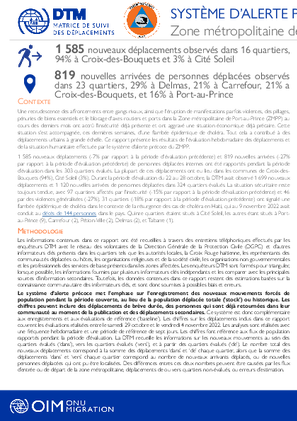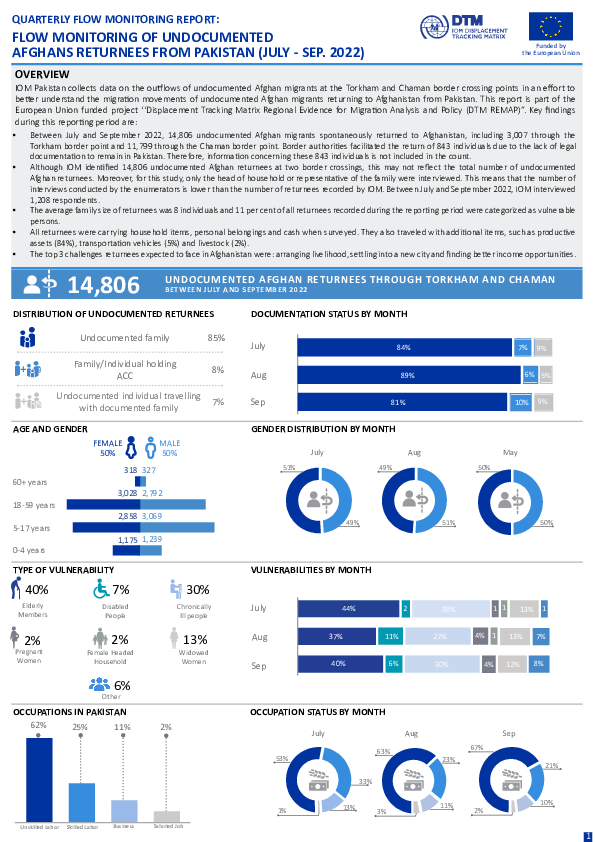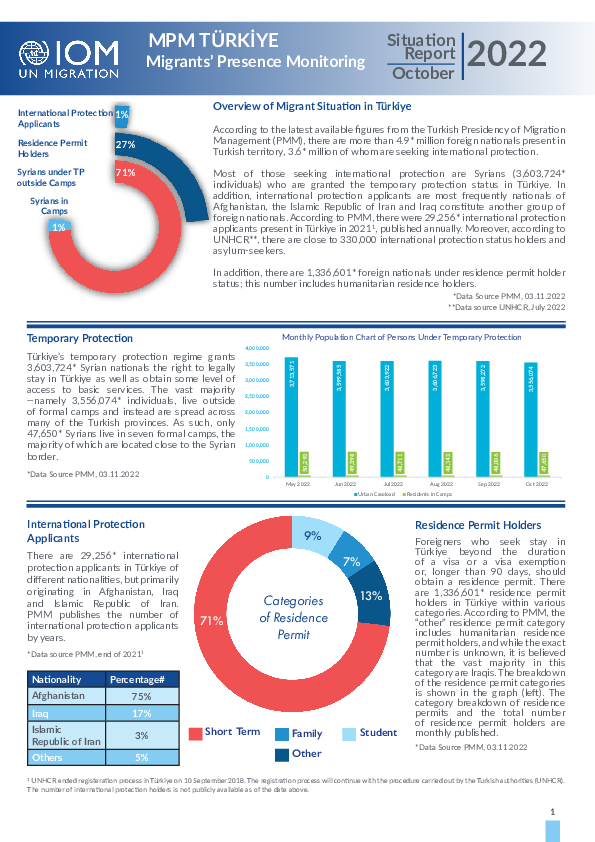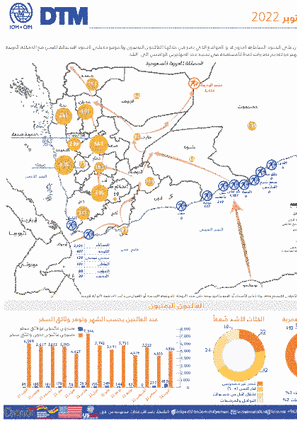-
Countries
-
Data and Analysis
-
Special Focus
-
Crisis Responses

Contact
dtmhaiti@iom.int
Language
French
Location
Haiti
Period Covered
Oct 29 2022
Nov 04 2022
Activity
- Event Tracking
Une recrudescence des affrontements entre gangs rivaux, ainsi que l'éruption de manifestations parfois violentes, des pillages, pénuries de biens essentiels et le blocage d'axes routiers et ports dans la Zone métropolitaine de Port-au-Prince (ZMPP) au cours des derniers mois ont accrû l'insécurité déjà présente et ont aggravé une situation économique déjà précaire. Cette situation s'est accompagnée, ces dernières semaines, d'une flambée épidemique de choléra. Tout cela a contribué à des déplacements urbains à grande échelle.
Ce rapport présente les résultats de l'évaluation hebdomadaire des déplacements et de la situation humanitaire effectuée par le système d'alerte précoce du ZMPP. 1 585 nouveaux déplacements (-7% par rapport à la période d'évaluation précédente) et 819 nouvelles arrivées (-27% par rapport à la période d'évaluation précédente) de personnes déplacées internes ont été rapportés pendant la période d’évaluation dans les 303 quartiers évalués. La plupart de ces déplacements ont eu lieu dans les communes de Croix-des-Bouquets (94%), Cité Soleil (3%). Durant la période d’évaluation du 22 au 28 octobre, la DTM avait observé 1 699 nouveaux déplacements et 1 120 nouvelles arrivées de personnes déplacées dans 324 quartiers évalués.
La situation sécuritaire reste toujours tendue, avec 97 quartiers affectés par l'insécurité (-15% par rapport à la période d'évaluation précédente) et 46 par des violences généralisées (-27%). 31 quartiers (-18% par rapport à la période d'évaluation précédente) ont signalé une flambée épidémique de choléra dans le contexte de la résurgence des cas de choléra en Haïti, qui au 9 novembre 2022 avait conduit au décès de 144 personnes dans le pays. Quinze quartiers étaient situés à Cité Soleil, les autres étant situés à Port-au-Prince (9), Carrefour (2), Pétion-Ville (2), Delmas (2), et Tabarre (1).

Contact
DTM Uganda, dtmuganda@iom.int
Language
English
Location
Uganda
Period Covered
Sep 01 2022
Sep 30 2022
Activity
- Flow Monitoring
In September 2022, a total of 2,007 people were interviewed at four Flow Monitoring Points (FMPs) across the border between Uganda and Kenya. The majority of people interviewed were incoming to Uganda (57%) against outgoing to Kenya (43%).
More inflows were observed during the reporting period as compared to outflows across most flow monitoring points as illustrated in the map. Most people acquire information about jobs or business offers across the border from friends, relatives or community at their usual residences or at places of destination. The majority (56%) of outgoing movements are for economic reasons.

Contact
DTM Pakistan, iomisbdtmremapteam@iom.int
Language
English
Location
Pakistan
Period Covered
Oct 08 2022
Oct 21 2022
Activity
- Flow Monitoring
IOM Pakistan collects data on the outflows of undocumented Afghan migrants at the Torkham and Chaman border crossing points in an effort to better understand the migration movements of undocumented Afghan migrants returning to Afghanistan from Pakistan. This exercise is part of the European Union funded project “Displacement Tracking Matrix Regional Evidence for Migration Analysis and Policy (DTM REMAP)”.
Between 8 October and 21 October 2022, 3,054 undocumented Afghan migrants spontaneously returned to Afghanistan, including 391 through the Torkham border point and 2,663 through the Chaman border point. Border authorities facilitated the return of 99 individuals due to the lack of legal documentation to remain in Pakistan. Therefore, information concerning these individuals are not included in the count. Although IOM identified 3,054 undocumented Afghan returnees at two border crossings, this may not reflect the total number of undocumented Afghan returnees. Moreover, for this study, only the head of household or representative of the family were interviewed. This means that the number of interviews conducted by the enumerators is lower than the number of returnees recorded by IOM. Between 8 and 21 October 2022, IOM interviewed 197 respondents.

Contact
DTM Pakistan, iomisbdtmremapteam@iom.int
Language
English
Location
Pakistan
Period Covered
Jul 01 2022
Sep 30 2022
Activity
- Flow Monitoring
IOM Pakistan collects data on the outflows of undocumented Afghan migrants at the Torkham and Chaman border crossing points in an effort to better understand the migration movements of undocumented Afghan migrants returning to Afghanistan from Pakistan. This report is part of the European Union funded project ‘‘Displacement Tracking Matrix Regional Evidence for Migration Analysis and Policy (DTM REMAP)”. Key findings during this reporting period are:
- Between July and September 2022, 14,806 undocumented Afghan migrants spontaneously returned to Afghanistan, including 3,007 through the Torkham border point and 11,799 through the Chaman border point. Border authorities facilitated the return of 843 individuals due to the lack of legal documentation to remain in Pakistan. Therefore, information concerning these 843 individuals is not included in the count.
- Although IOM identified 14,806 undocumented Afghan returnees at two border crossings, this may not reflect the total number of undocumented Afghan returnees. Moreover, for this study, only the head of household or representative of the family were interviewed. This means that the number of interviews conducted by the enumerators is lower than the number of returnees recorded by IOM. Between July and September 2022, IOM interviewed 1,208 respondents.
- The average family size of returnees was 8 individuals and 11 per cent of all returnees recorded during the reporting period were categorized as vulnerable persons.
- All returnees were carrying household items, personal belongings and cash when surveyed. They also traveled with additional items, such as productive assets (84%), transportation vehicles (5%) and livestock (2%).
- The top 3 challenges returnees expected to face in Afghanistan were: arranging livelihood, settling into a new city and finding better income opportunities

Contact
DTM Cameroon, DTMCameroun@iom.int
Language
French
Location
Cameroon
Period Covered
Nov 07 2022
Nov 08 2022
Activity
- Mobility Tracking
- Event Tracking
Le suivi des situations d’urgence (en anglais, Emergency Tracking Tool, ETT) est une des composantes de la Matrice de suivi des déplacements (DTM) déployée par l’Organisation Internationale pour les Migrations (OIM). Il a pour objectif de rassembler des informations sur les mouvements significatifs et soudains de populations ainsi que sur des urgences sécuritaires et climatiques. Les données ont été collectées par observation directe et par des entretiens téléphoniques, auprès de 10 informateurs clés, principalement les autorités locales, les Organisations Non Gouvernementales (ONGs) les organisations de la société civile (OSCs) et les représentants des populations sinistrées dans les lieux affectés. Ce tableau de bord présente les informations sur les personnes affectées par la montée des eaux du fleuve Logone ayant provoqué des inondations et plusieurs dégâts matériels.
Dans la nuit du 07 au 08 novembre 2022 au tour de 02h du matin, la localité de Koundoué 1 dans l’arrondissement de Goulfey, département du Logone et Chari, dans la région de l’Extrême-Nord du Cameroun a été victimes de la montée des eaux (inondations) qui a provoqué le déplacement de plusieurs centaines de personnes. Ce déplacement a contraint les populations à laisser derrière elles leurs biens en se dirigeant vers un site spontané d'urgence non loin de la localité.

Contact
DTM Europe, DTMMediterranean@iom.int
Language
English
Location
Republic of Türkiye
Period Covered
Oct 01 2022
Oct 31 2022
Activity
- Flow Monitoring
- Migrants presence
- Mobility Tracking
According to the latest available figures from the Turkish Presidency of Migration Management (PMM), there are more than 4.9* million foreign nationals present in Turkish territory, 3.6* million of whom are seeking international protection. Most are Syrians (3,603,724* individuals) who are granted temporary protection status. In addition, international protection applicants from countries including Afghanistan, the Islamic Republic of Iran and Iraq constitute another group of foreign nationals. According to PMM, there were 29,256* international protection applicants present in Türkiye in 20211, published annually. Moreover, according to UNHCR**,
there are close to 330,000 international protection status holders and asylum-seekers. The number of foreign nationals has decreased by 124,560 in comparison to October 2021 (3.7 million foreign nationals).
In addition, there are 1,336,601* foreign nationals present in Türkiye holding residency permits, including humanitarian residency holders. Compared to October 2021, this is an increase of 94,757 individuals. The exact number of humanitarian residency holders is
unknown, but it is estimated that there are more than several thousand humanitarian residency permit holders.
*Data source PMM, 03.11.2022
**Data source UNHCR, July 2022

Contact
DTM Europe, DTMMediterranean@iom.int
Language
English
Location
Republic of Türkiye
Period Covered
Oct 01 2022
Oct 31 2022
Activity
- Flow Monitoring
- Migrants presence
- Mobility Tracking
According to the latest available figures from the Turkish Presidency of Migration Management (PMM), there are more than 4.9* million foreign nationals present in Turkish territory, 3.6* million of whom are seeking international protection.
Most of those seeking international protection are Syrians (3,603,724* individuals) who are granted the temporary protection status in Türkiye. In addition, international protection applicants are most frequently nationals of Afghanistan, the Islamic Republic of Iran and Iraq constitute another group of foreign nationals. According to PMM, there were 29,256* international protection applicants present in Türkiye in 20211, published annually. Moreover, according to UNHCR**, there are close to 330,000 international protection status holders and asylum-seekers.
In addition, there are 1,336,601* foreign nationals under residence permit holder status; this number includes humanitarian residence holders.
*Data Source PMM, 03.11.2022
**Data source UNHCR, July 2022

Contact
DTM Nigeria, AllUsersInDTMNigeria@iom.int
Language
English
Location
Nigeria
Period Covered
Oct 28 2022
Nov 01 2022
Activity
- Event Tracking
The rainy season in Nigeria typically occurs annually with the greatest concentration of precipitation between the months of June and September. Many states in Nigeria have been affected by unprecedented heavy rainfalls and floods have devastated various communities. Infrastructure, crops, and shelters have been damaged which led to decimated livelihoods and the displacement of numerous households. Over the past months, climate variability and the release of excess water from the Lagdo dam in northern Cameroon, have worsened the flood situation and has resulted in a renewed situation of widespread displacement across Nigeria.
Between 28 October and 1 November 2022, DTM, in collaboration with the National Emergency Management Agency (NEMA), the Anambra State Emergency Management Agency (ASEMA) and the Nigerian Red Cross Society (NCRS) identified 36 locations in Anambra State that were affected by the floods and/or received IDPs that are currently displaced as a result of the floods.˝ Through a network of 95 key informants and field focal points and in close coordination with other humanitarian partners and local authorities on ground, DTM conducted assessments in these locations to inform the humanitarian community on the main needs, vulnerabilities and mobility intentions of the affected population.
In the seven (7) Local Government Areas (LGAs) of Anambra state assessed, DTM identified 35,074 individuals in 6,980 households that were affected by the floods. These individuals included both IDPs that were living in camp-like settings and residents who were impacted by the floods but remained in their communities.
Contact
iomyemendtm@iom.int
Location
Yemen
Activity
- Flow Monitoring
Period Covered
Oct 01 2022 -Oct 31 2022
In October 2022, IOM Yemen DTM recorded 6,381 migrants entering Yemen, an six per cent increase compared to September 2022 (6,041). In Lahj DTM has registered an increase in arrivals (+ 60%) compared to the last month in contrast to Shabwah, which registered a decrease this month (- 31%). The overall increase could be linked to weather conditions, sea tides and decreased coast guard patrolling in Djibouti. While travel had been primarily due to economic reasons in the first half of the year, DTM has been recording conflict induced movements since August, being the reason for 35 per cent of all incoming movements in October. All conflict motivated travel was recorded in Shabwah coming from Bari, Somalia (28% children, 21% women and 51% men).
Due to the deteriorating humanitarian crisis in Yemen and the challenges in moving towards KSA, many migrants opted to return to the Horn of Africa. DTM teams in Djibouti recorded that during October 2022, a total of 648 migrants took the risky return by boat from Yemen to travel home. Moreover, DTM recorded 5,454 Yemeni returns from KSA during the month of October 2022, compared to 4,532 in September 2022. Between 1 January and 31 October 2022, DTM recorded 53,401 migrants and 55,269 Yemeni migrant returnees to Yemen.
The migrant caseload was around 96 per cent Ethiopian nationals, and around four per cent Somali nationals. The migrants are predominantly male (64%), with (23%) women, seven per cent boys and six per cent girls also among the travelers.
Through September’s reporting period, 2,502 migrants arrived from Somalia and were recorded 1,957 at Ber Ali, 325 at Araqah and 218 at Eyn Bamabad flow monitoring points in Shabwah governorate. In Lahj governorate, 3,876 migrants arrived from Djibouti, where 3,101 were recorded at Al Makhabbah flow monitoring point (FMP), 407 at Al Cawhah FMP, 159 at Hasy Eisa FMP, 101 at Al-Batin FMP, 88 at Al Azaf FMP, and 20 at Al Hejaf FMP.
Population Groups
Survey Methodology
Unit of Analysis Or Observation
Type of Survey or Assessment
Keywords
Geographical Scope
Administrative boundaries with available data
The current dataset covers the following administrative boundaries

Contact
DTM Yemen, iomyemendtm@iom.int
Language
Arabic
Location
Yemen
Period Covered
Oct 01 2022
Oct 31 2022
Activity
- Flow Monitoring
في اكتوبر 2022 ، سجلت مصفوفة تتبع النزوح (DTM) التابعة للمنظمة الدولية للهجرة في اليمن 6,381 مهاجرًا دخلوا اليمن ،بزيادة قدرها (%6) مقارنة بـ 6,041 مهاجرًا في سبتمبر 2022. سجلت مصفوفة تتبع النزوح في محافظة لحج زيادة في عدد الوافدين (60+%) مقارنة بالشهر الماضي على عكس شبوة التي شهدت انخفاضاً هذا الشهر (31-%). ويمكن ربط الزيادة العام بالأحوال الجوية والمد البحري وانحفاض دوريات خفر السواحل في جيبوتي. في حين أن الهحرة كانت في المقام الأول لأسباب اقتصادية في النصف الأول من العام ، فإن مصفوفة تتبع النزوح كانت تسجل الصراع منذ أغسطس ، على انه السبب وراء 35 في المائة من جميع التحركات الواردة في أكتوبر. تم تسجيل جميع رحلات السفر بدافع الصراع في شبوة قادمة من باري ، الصومال (28٪ أطفال ، 21٪ نساء و 51٪ رجال).
بسبب الأزمة الإنسانية المتدهورة في اليمن والتحديات في المضي قدمًا نحو المملكة العربية السعودية ، اختار العديد من المهاجرين العودة إلى القرن الأفريقي. حيث سجلت فرق مصفوفة تتبع النزوح في جيبوتي خلال اكتوبر 2022 ، خوض 648 مهاجراً رحلة العودة الخطرة على متن قوارب من اليمن. بالإضافة إلى ذلك ، سجلت مصفوفة تتبع النزوح في اليمن حوالي 5,454 يمني عادوا من المملكة العربية السعودية خلال شهر اكتوبر، مقارنة بـ 4,532 في سبتمبر 2022. خلال الفترة بين 1 يناير و 31 اكتوبر 2022، وصل ما يقدر بـ 53,401 مهاجرًا و 55,269 يمنيًا عائداً إلى اليمن.
حيث مثل عدد المهاجرين من إثيوبيا96 % في المائة و اربعة في المائة من الصوماليين. كانت غالبية المهاجرين من الذكور (64) مع (23%) من النساء ، و سبعة في المائة من الأولاد وستة في المائة من الفتيات اللواتي كنا ايضاً من ضمن المسافرين.
خلال فترة التقرير في اكتوبر 2022، شوهد وصول 2,876 مهاجرا من الصومال وتم تسجيلهم في نقاط مراقبة التدفق في محافظة شبوه حيث سجل عدد 1,9587 في بئر علي و ا 325 في عرقة. بينما شهدت نقاط مراقبة التدفق بمديرية المضاربة والعارة بمحافظة لحج وصول 3,876 مهاجرا وصلوا من جيبوتي , حيث تم تسجيل 3,101 في المخابأه ؛ وا 407 في الكوحه ؛ وا 159 في حسي عيسى ؛ وا 101 في الباطن ؛ وا 88 في العزاف وا 20 في الحجيف.